Planning your dream trip to Japan? For many, the Land of the Rising Sun sits firmly at the top of the travel bucket list, brimming with unique culture, breathtaking landscapes, and delicious cuisine. If you’re looking to make the most of your first adventure, crafting the perfect Japan Travel Itinerary 2 Weeks long is key. This guide will walk you through an efficient and unforgettable two-week journey, designed to showcase the best of Japan for first-time visitors, ensuring you experience a rich tapestry of modern cities and ancient traditions without feeling rushed.
You’re likely drawn to Japan by the same allure that captivated me years ago. From a young age, I dreamt of experiencing this incredible country. When I finally stepped onto Japanese soil, the reality exceeded even my wildest expectations. The vibrant cities, serene temples, and warm hospitality left an indelible mark, sparking a lifelong passion for Japan that has led to multiple return trips.
Perhaps you find yourself in a similar position – eager to explore Japan but feeling overwhelmed by the planning process. The desire to see and do everything in a limited timeframe can be daunting. Rest assured, you’re not alone! This meticulously crafted 2-week Japan itinerary is designed to alleviate that stress. It’s based on my own experiences and refined over several trips, specifically tailored for first-time visitors who want to maximize their time and create lasting memories.
Let’s embark on this exciting journey together and discover the magic of Japan!
Your 2-Week Japan Adventure: Cities & Cultural Highlights
This comprehensive 2-week japan travel itinerary focuses on providing a balanced experience, blending iconic urban landscapes with cultural immersion and natural beauty. We’ll be navigating a route that touches upon the famed Golden Route, while incorporating some personal recommendations to enrich your journey. Expect to explore the dazzling metropolis of Tokyo (3 days), witness the majesty of Mount Fuji (1 day), delve into cultural day trips to Hakone, Nikko, or Kamakura (2 days), experience the historical heart of Kyoto (3 days), savor the culinary delights of Osaka (1 day), encounter friendly deer in Nara (1 day), marvel at the pristine Himeji Castle (1 day), and reflect in the poignant city of Hiroshima and serene Miyajima Island (2 days).
While this itinerary covers a diverse range of destinations, it’s structured to minimize travel fatigue. You won’t be constantly packing and unpacking. Instead, we’ll strategically utilize key cities as bases for exploration, making use of Japan’s exceptional public transportation system for efficient day trips. This approach allows you to settle into comfortable accommodations and venture out each day, returning to your “home base” in the evening. You’ll only need to change hotels a few times throughout the two weeks, maximizing your relaxation and exploration time.
Two weeks provides an excellent introduction to Japan, allowing you to delve into its highlights without feeling hurried. To help you visualize this journey, here’s a map outlining our points of interest. For seamless navigation during your trip, consider downloading Google Maps – you can even save this interactive map to your device for offline access, ensuring you don’t miss any of the recommended spots.
Beyond the major attractions, this Google Map also includes some of my personal favorite hidden gems: charming coffee shops, authentic local restaurants, and unique stores that offer a taste of Japanese daily life. These curated recommendations will help you experience Japan beyond the typical tourist trail.
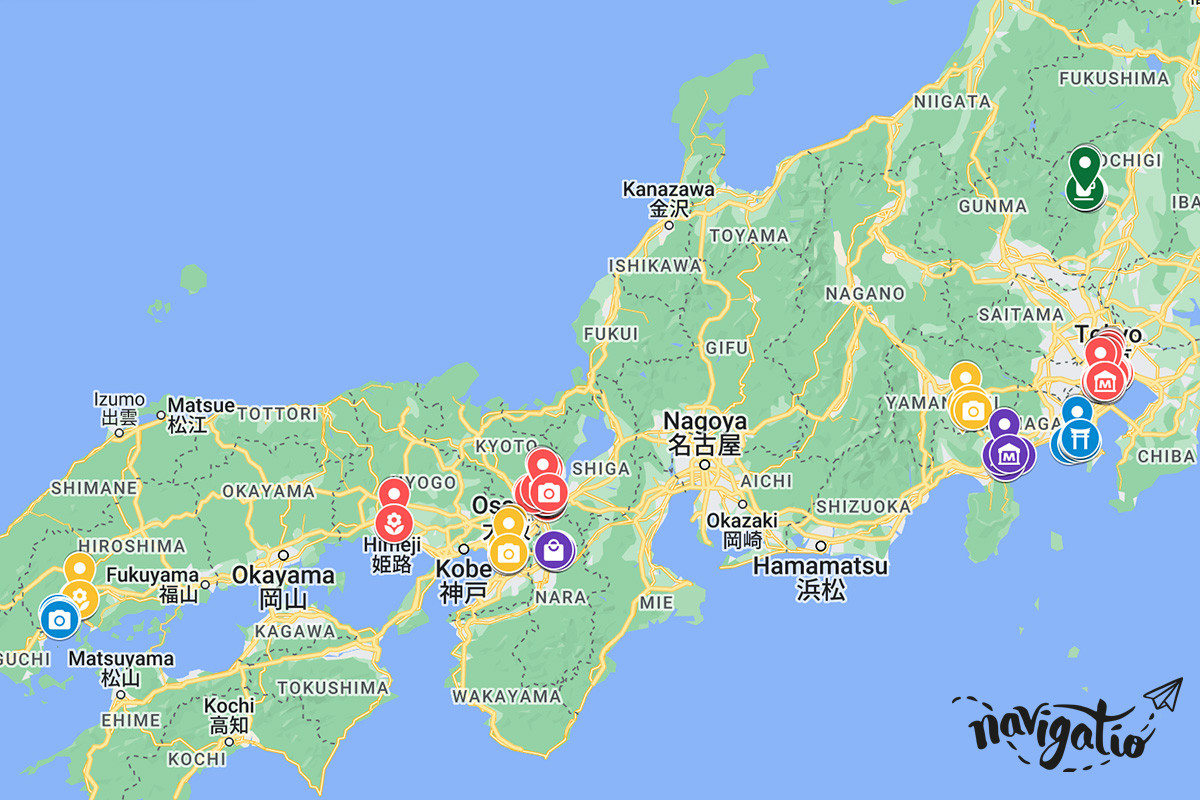 two week Japan itinerary map
two week Japan itinerary map
Click here for the interactive Google Maps
Strategic Accommodation: Where to Stay During Your 2-Week Japan Trip
To optimize your 2 weeks in Japan and avoid the hassle of daily luggage transfers, we’ll establish a few strategic “home bases.” Japan’s public transportation is not only efficient but also incredibly user-friendly, making day trips a breeze. We’ll leverage this system to its fullest potential. Furthermore, the locations in this itinerary are exceptionally well-connected by public transport, and I will highlight any cost-saving discount passes available to make your day trips even more economical and convenient.
To maximize your holiday experience, I recommend booking accommodations in the following cities for the specified durations:
| Days | City | Recommended Hotel/Area |
|---|---|---|
| 1–6 | Tokyo | Where to stay in Tokyo (full guide) |
| 7–11 | Kyoto | Where to stay in Kyoto (full guide) |
| 12–14 | Hiroshima | Where to stay in Hiroshima (guide will be published soon) |
Enhance Your Japan Trip Planning
For even more inspiration and detailed information to refine your itinerary, explore these additional Japan travel guides:
[Link to other Japan guides on the website]
Stay seamlessly connected throughout your Japanese adventure with a Pocket WiFi – an essential tool for navigating Google Maps and utilizing translation apps! Take advantage of a 15% discount on Ninja WiFi Pocket WiFi using the code THENAVIGATIO15.
Detailed 2-Week Japan Itinerary: Day-by-Day Guide
Here is your comprehensive 2-week Japan itinerary, ready to be followed step-by-step or customized to align with your personal travel preferences:
Days 1-3: Tokyo – Immersing Yourself in the Electric City
Our Japanese adventure begins in Tokyo, the vibrant capital city. As the primary gateway for international travelers, with both Haneda and Narita airports serving as major hubs, Tokyo is the ideal starting point for your 2-week japan travel itinerary.
Upon arrival at either airport, you have several convenient options to reach the city center: efficient public transportation, pre-booked airport transfers, or readily available taxis. While navigating Tokyo’s public transport might initially seem intimidating, it’s undoubtedly the most cost-effective and surprisingly straightforward choice.
Consider acquiring a Suica or Pasmo card right at the airport train station. These rechargeable e-money cards are indispensable for seamless travel on public transport throughout Japan and are consistently ranked among the best Japan travel apps. Alternatively, you can conveniently add a digital Suica or Pasmo card directly to your iPhone for even greater ease of use.
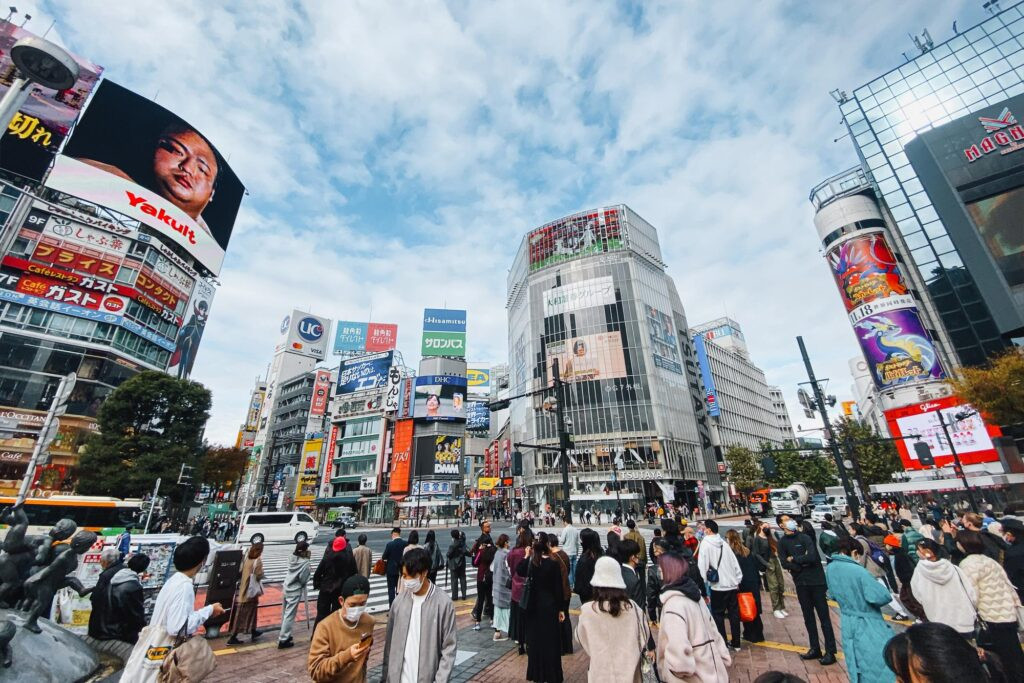 shibuya crossing tokyo
shibuya crossing tokyo
Given that our first six days will be centered in and around Tokyo, it’s recommended to book your Tokyo accommodation for the entire initial six-night stay. Staying in one hotel for this duration eliminates the need to constantly move luggage, allowing you to explore freely with just a daypack for any day trips.
Choosing where to stay in Tokyo, one of the world’s largest and most dynamic cities, can feel overwhelming. For first-time visitors, areas like Minato, Asakusa, or Roppongi are excellent choices, offering a blend of convenience, attractions, and comfortable accommodations.
For a more detailed breakdown of Tokyo’s neighborhoods and hotel recommendations tailored to different travel styles, refer to our comprehensive guide on where to stay in Tokyo. However, for first-time visitors, here are my top recommendations:
| Area | Best For | Hotel | Book Now |
|---|---|---|---|
| Minato | First-time visitors, central location | Park Hotel Tokyo | Check Availability |
| Asakusa | Budget-conscious travelers, traditional atmosphere | Hotel Sunroute Asakusa | Check Availability |
| Roppongi | Luxury travelers, nightlife, art museums | The Prince Park Tower Tokyo | Check Availability |
Day 1: Tokyo – Culture, Pop Culture, and City Views
Tokyo is a city of endless discovery. You could easily dedicate a month to exploring its diverse neighborhoods and still uncover new facets. However, to make the most of your 2-week japan travel itinerary, I’ve curated a three-day Tokyo experience that captures the city’s essential highlights and provides a fantastic first impression.
Day one is designed to introduce you to Tokyo’s captivating blend of serene cultural sites and vibrant, modern districts:
- Morning: Meiji Shrine (Meiji Jingu): Begin your Tokyo exploration with a visit to Meiji Shrine, a peaceful oasis nestled within one of Tokyo’s largest parks. Step through a towering wooden torii gate near Harajuku Station and enter a tranquil forest of over 100,000 trees, leading you to the serene shrine dedicated to Emperor Meiji and Empress Shoken. Don’t miss the iconic wall adorned with over 200 traditional sake barrels, a testament to the shrine’s cultural significance.
- Mid-day: Harajuku Exploration & Takeshita Street: Adjacent to Meiji Shrine lies Harajuku, a district famous for its unique street style and youth culture. Wander down Takeshita Street, Harajuku’s bustling pedestrianized shopping street, known for its colorful fashion boutiques, quirky cafes, and crepe stands. Continue towards Omotesando, often referred to as Tokyo’s Champs-Élysées, for a more upscale shopping experience and to observe Harajuku’s distinctive fashion scene.
- Afternoon: Purikura Fun: Immerse yourself in Japanese pop culture with a Purikura experience. Unlike standard photo booths, Purikura booths are kawaii (cute) photo booths that allow you to take pictures with fun filters, digital enhancements, and customizable stickers and text. Create unique and memorable keepsakes from your Japan trip.
- Late Afternoon: Shibuya Crossing & Hachiko Statue: Take a short metro ride or a 15-minute walk to Shibuya, home to the world-renowned Shibuya Crossing, often dubbed the busiest intersection globally. Witness the organized chaos of pedestrians navigating this iconic scramble crossing. For an elevated view, grab a drink at L’Occitane Cafe, Cé La Vi, or the newly renovated Starbucks, all offering prime vantage points overlooking the crossing. Just outside Shibuya Station, pay homage to the Hachiko Statue, commemorating the loyal Akita dog who waited for his owner at the station for years.
- Evening: Shibuya Sky & Shibuya Center Gai: Ascend to Shibuya Sky for breathtaking panoramic views of Tokyo. This 360-degree open-air observation deck is especially stunning around sunset (booking tickets in advance is highly recommended). On a clear day, you might even glimpse Mount Fuji in the distance. Afterwards, dive into the vibrant atmosphere of Shibuya Center Gai, a narrow, bustling street in Shibuya known for its eclectic mix of shops, restaurants, izakayas (Japanese pubs), and nightlife. It’s the perfect place to experience Tokyo’s energetic evening ambiance and grab dinner.
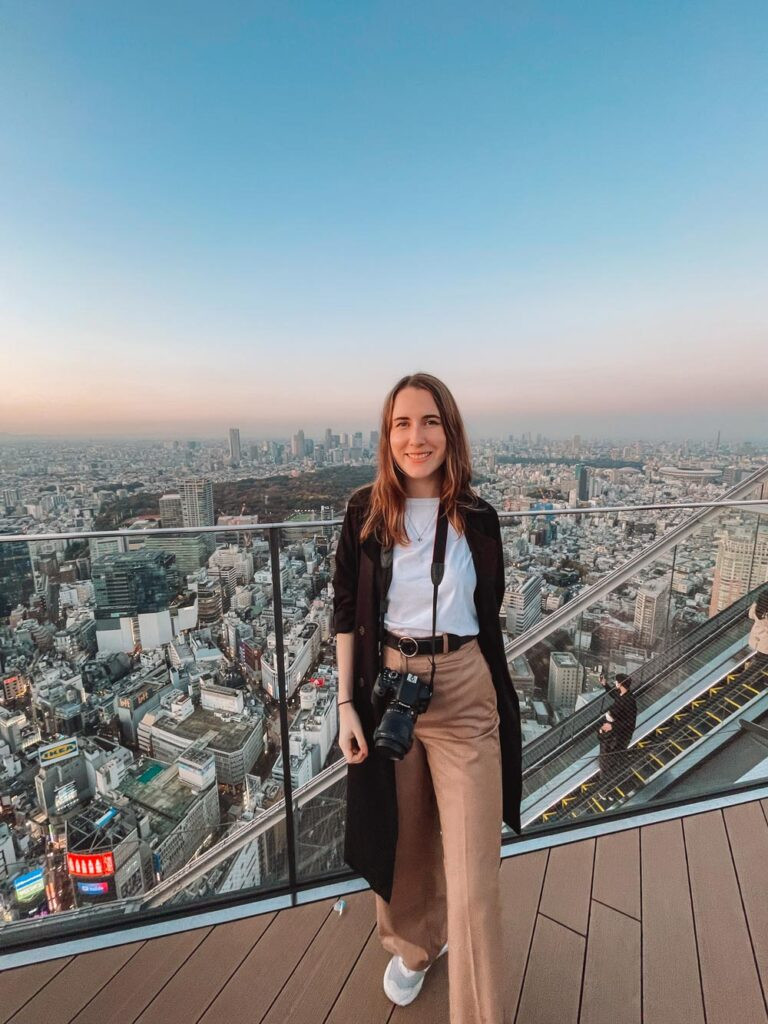 shibuya sky tokyo
shibuya sky tokyo
Day 2: Tokyo – Tradition Meets Electric Town
Day two of our Tokyo itinerary offers a fascinating contrast, moving from the traditional charm of Asakusa to the futuristic energy of Akihabara, also known as “Electric Town.” This day showcases diverse facets of Tokyo, from ancient temples to cutting-edge technology and pop culture:
- Morning: Senso-ji Temple & Nakamise Street: Begin your day in Asakusa, Tokyo’s oldest temple district. Explore Senso-ji Temple, Tokyo’s oldest temple, dating back to 645 AD. Wander through the temple grounds, admiring the beautiful architecture, serene gardens, and the iconic Kaminarimon Gate with its giant red lantern. Try o-mikuji, Japanese fortune-telling, at Senso-ji. For a small donation (typically 100 yen), shake a wooden box until a numbered stick falls out, revealing your fortune (ranging from excellent luck to bad luck). Just outside the main temple, stroll down Nakamise Street, a vibrant 200-meter-long street lined with traditional shops selling souvenirs, local crafts, and delicious street food snacks.
- Mid-day: Ueno Park, Kappabashi, & Ueno Ameyoko Market: Head to Ueno Park, a sprawling urban oasis renowned as one of Tokyo’s best cherry blossom viewing spots (especially beautiful in late March/early April). Even outside cherry blossom season, Ueno Park offers several excellent museums, including the Tokyo National Museum and the Ueno Royal Museum. Keep an eye out for Pokemon-themed manhole covers scattered throughout the park. From Ueno Park, venture towards Kappabashi, a unique street specializing in kitchenware. Explore shops selling everything from exquisite Japanese knives (renowned for their quality and sharpness) to ceramics, cookware, and restaurant supplies – a haven for culinary enthusiasts. Enjoy lunch or explore the lively atmosphere of Ueno Ameyoko Market, a bustling open-air market offering a wide array of goods, from fresh produce and seafood to clothing and cosmetics.
- Afternoon/Evening: Akihabara – Electric Town & Arcade Fun: Immerse yourself in the electric atmosphere of Akihabara, “Electric Town,” the epicenter of anime, manga, video games, and electronics culture. Explore countless stores specializing in retro video games, anime figures, manga, electronics components, and gadgets. Pop culture enthusiasts should dedicate ample time to explore this area (and ensure sufficient suitcase space for souvenirs!). Refer to the interactive map for recommended retro game shops. Experience the thrill of Japanese arcades in Akihabara. These multi-story entertainment centers offer a wide array of games, from classic arcade cabinets to crane games and rhythm games. Venture beyond the ground floor for a wider selection of games beyond crane machines.
 sensoji temple in spring
sensoji temple in spring
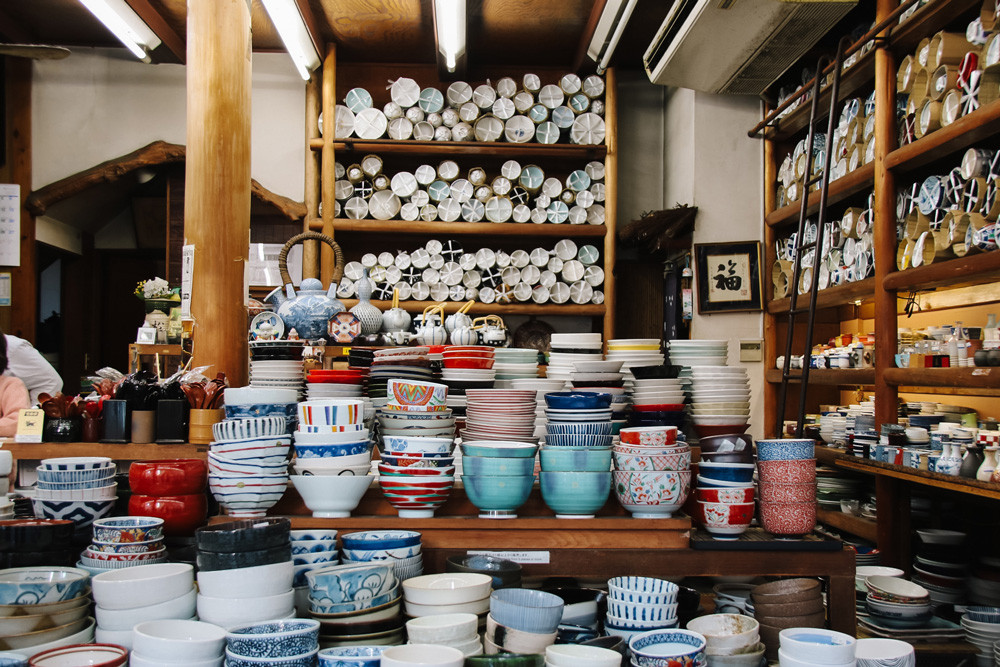 kappabashi tokyo
kappabashi tokyo
Day 3: Tokyo – Imperial History & Modern Skylines
Our final day in Tokyo before venturing beyond the capital allows us to explore more historical landmarks and enjoy stunning cityscapes:
- Morning: Tokyo Imperial Palace & Zōjō-ji Temple: Begin your day with a visit to the Tokyo Imperial Palace, the primary residence of the Emperor of Japan. Tokyo became Japan’s capital in 1868 when the Emperor relocated from Kyoto. The current Imperial Palace is built on the former site of Edo Castle, a significant historical landmark. Guided tours of the Imperial Palace are recommended as access to certain areas is restricted without a tour. En route to Tokyo Tower, make a brief stop at Zōjō-ji Temple, a beautiful Buddhist temple complex offering excellent views of Tokyo Tower.
- Mid-day: Tokyo Tower & Roppongi Art Triangle: Capture iconic photos of Tokyo Tower, one of Tokyo’s most recognizable symbols. While ascending to the top of Tokyo Tower is an option, consider alternative viewpoints in Roppongi (like Roppongi Hills Mori Tower) for arguably superior skyline views that include Tokyo Tower itself. Explore Roppongi, a district renowned for its art museums and galleries. The Roppongi Art Triangle encompasses three prominent museums: Mori Art Museum (known for contemporary art and panoramic city views), the National Art Gallery, Tokyo (showcasing a vast collection of Japanese and international art), and the Suntory Museum of Art (featuring Japanese antiques and decorative arts). If time permits for only one museum, Mori Art Museum is highly recommended for its art exhibitions and exceptional city views. Consider visiting 21_21 DESIGN SIGHT, another notable museum in Roppongi focusing on contemporary Japanese design and innovation.
- Evening: Karaoke Fun in Roppongi: Experience Japanese karaoke in Roppongi. Unlike Western karaoke bars, Japanese karaoke establishments offer private rooms for groups to sing in, providing a more personalized and often humorous experience. Order drinks and snacks directly to your karaoke room and unleash your inner performer!
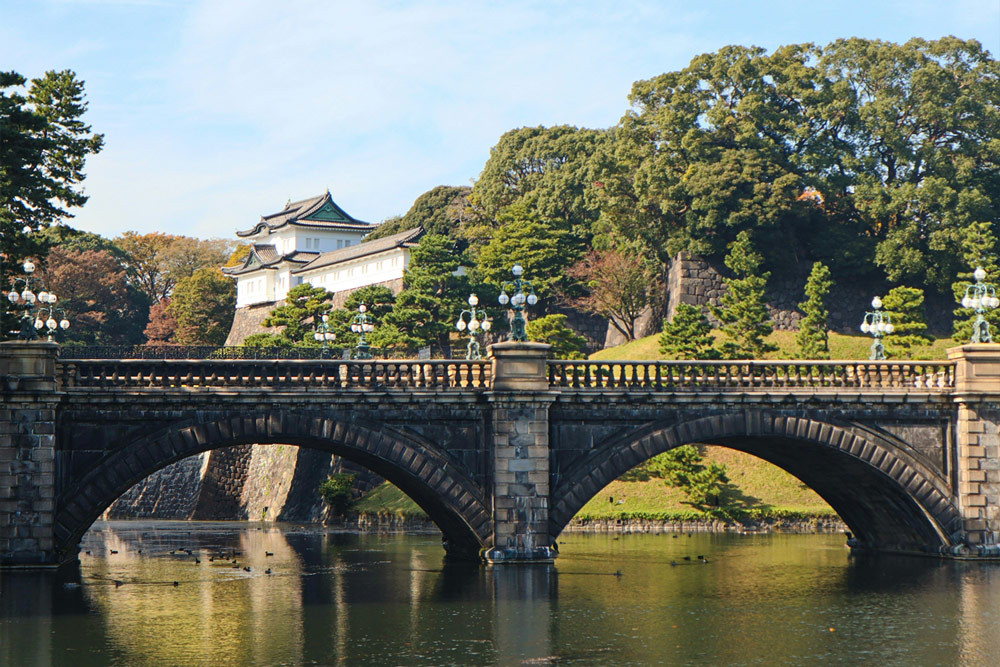 tokyo imperial palace
tokyo imperial palace
Day 4: Mount Fuji – Witnessing Japan’s Iconic Peak
No 2-week japan travel itinerary is complete without experiencing the majestic Mount Fuji, Japan’s iconic and sacred volcano. While climbing Mount Fuji during the official hiking season (July to September) is possible, it’s a strenuous undertaking that can take up to 10 hours. For a day trip from Tokyo, it’s more rewarding to explore the areas surrounding Mount Fuji and soak in the stunning views.
The most popular and accessible way to experience Mount Fuji is to travel to Lake Kawaguchiko by bus or train. Lake Kawaguchiko offers breathtaking panoramic views of Mount Fuji reflected in its serene waters. Upon arrival at Lake Kawaguchiko, consider renting a bicycle to explore the lake’s perimeter at your own pace. Cycling around the lake allows you to discover various viewpoints and enjoy the fresh mountain air. Make your way to the Chureito Pagoda, perched on a mountainside overlooking Fujiyoshida City and Lake Kawaguchiko, for arguably the most iconic and photographed view of Mount Fuji, especially stunning during cherry blossom season or autumn foliage.
Alternatively, for a more structured and hassle-free experience, consider booking a fully guided day tour from Tokyo. While a DIY trip to Mount Fuji is feasible, a guided tour ensures you visit key viewpoints and learn about the region’s history and culture, especially beneficial for first-time visitors.
It’s important to note that Mount Fuji is often shrouded in clouds. Predicting clear visibility in advance is challenging. Therefore, while in Japan, monitor weather forecasts and consider adjusting your itinerary to prioritize your Mount Fuji day trip on a day with favorable conditions. This website provides relatively accurate Mount Fuji visibility forecasts.
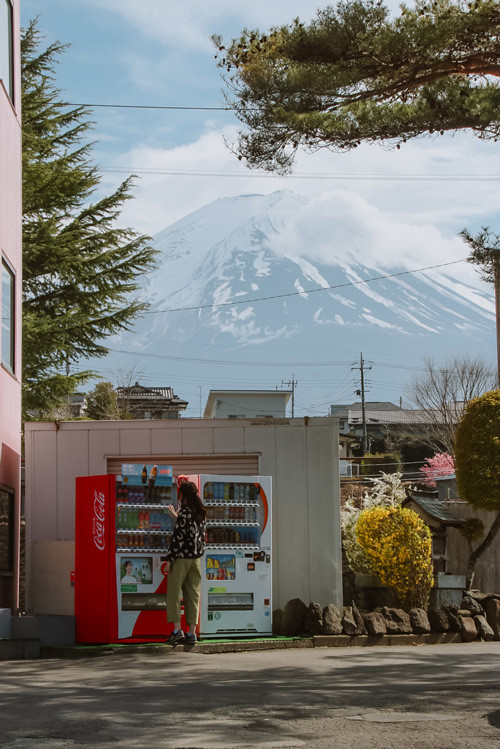 mount fuji and vending machine
mount fuji and vending machine
Days 5-6: Day Trip Choices – Hakone, Nikko, or Kamakura
For days five and six of your 2-week japan travel itinerary, you have the flexibility to choose two day trip destinations from Tokyo based on your interests. The areas surrounding Tokyo offer a wealth of diverse experiences, from natural beauty to historical sites. I’ve selected three excellent day trip options – Hakone, Nikko, and Kamakura – each offering a unique glimpse into different aspects of Japan. Read through the descriptions below to determine which two destinations resonate most with you and best complement your travel style.
Day Trip Option 1: Hakone – Mountain Scenery & Volcanic Hot Springs
Hakone is a personal favorite day trip destination from Tokyo. It boasts breathtaking views of Mount Fuji, some of Japan’s finest onsens (hot springs), and beautiful shrines nestled amidst stunning natural landscapes. Hakone also holds a special personal significance for me, as it’s where I got engaged!
Hakone is easily accessible from Tokyo, taking approximately 1–1.5 hours by train. This proximity makes it an ideal escape from the bustling metropolis, offering a chance to experience a different facet of Japan’s beauty and tranquility.
For a Hakone day trip, consider purchasing the Hakone Free Pass. This cost-effective pass includes round-trip transportation from Shinjuku Station in Tokyo to Hakone, unlimited rides on most public transport within the Hakone region (including the iconic Hakone Ropeway and the Lake Ashi cruise), and discounts at various attractions. It’s both a money-saver and a time-saver, streamlining your Hakone exploration.
When planning your Hakone day trip, here are some must-do activities and sights:
- Onsen Experience: Hakone is renowned as one of Japan’s premier onsen (hot spring) towns. Indulge in a rejuvenating onsen experience at one of Hakone’s numerous hot spring resorts or public baths. Be aware that most traditional onsens require bathing in the nude, with separate bathing areas for men and women.
- Hakone Shrine: A must-visit in Hakone is Hakone Shrine, a picturesque Shinto shrine nestled on the shores of Lake Ashi. The iconic red torii gate of Hakone Shrine, seemingly floating on Lake Ashi, is a popular photo spot. Be prepared for a potential wait to take photos at the torii gate, as it’s a highly sought-after spot.
- Owakudani – Boiling Valley: Take the Hakone Ropeway, a scenic gondola lift, up the mountainside to Owakudani, also known as “Boiling Valley.” This volcanic valley is a dramatic landscape resulting from a volcanic eruption 3,000 years ago. Witness steaming vents, sulfurous fumes, and bubbling hot springs, a testament to Hakone’s volcanic activity.
- Black Eggs (Kuro-tamago): While at Owakudani, sample Hakone’s famous black eggs (kuro-tamago). These chicken eggs are cooked in Owakudani’s volcanic hot springs. The volcanic minerals react with the eggshells, turning them black. Black eggs are perfectly safe to eat and are said to impart health benefits – legend claims that eating one black egg can extend your life by seven years!
For a more detailed itinerary and suggested route, refer to my one-day Hakone itinerary guide.
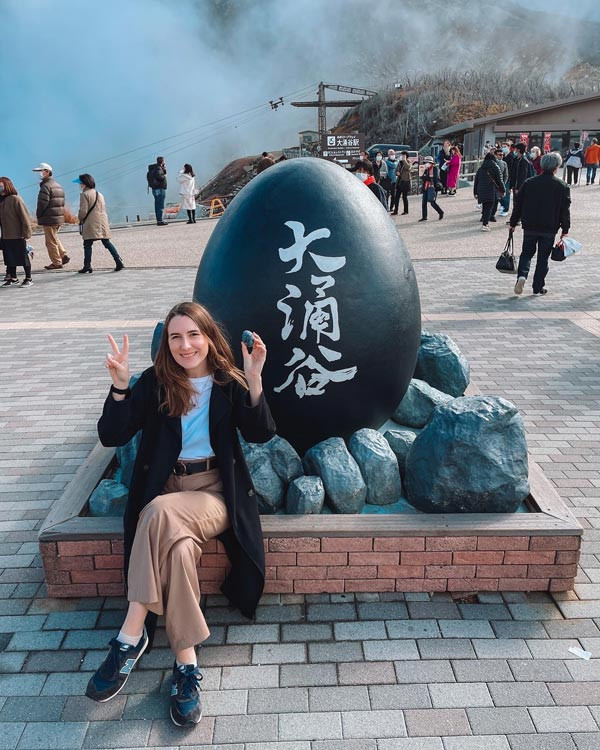 black egg hakone
black egg hakone
Hakone is also an excellent destination for an overnight stay, particularly if you wish to fully immerse yourself in the onsen experience and savor the region’s tranquility. Our guide on where to stay in Hakone features recommendations for some of the best ryokans (traditional Japanese inns) in Hakone, including those offering stunning Mount Fuji views.
Day Trip Option 2: Nikko – UNESCO World Heritage & Natural Beauty
Nikko, located slightly further from Tokyo than Hakone (approximately 2–3 hours travel time), is another exceptional day trip option. This mountain town is steeped in history and surrounded by breathtaking natural landscapes, including waterfalls, forests, and lakes. Nikko is a UNESCO World Heritage site, renowned for its elaborate shrines and temples.
If you plan a Nikko day trip, consider purchasing the Nikko World Heritage Area Pass. Similar to the Hakone Free Pass, this pass includes round-trip transportation from Tokyo to Nikko and unlimited rides on designated buses within the Nikko World Heritage area. The pass price is often less than the cost of a round-trip train ticket alone, making it a cost-effective option.
Key sights and activities for your Nikko day trip include:
- Shinkyo Bridge: Begin your Nikko exploration at Shinkyo Bridge, a strikingly beautiful vermilion-lacquered bridge spanning the Daiya River. From Nikko Station, it’s a short bus ride (about 5 minutes) to Shinkyo Bridge. This nearly 400-year-old bridge serves as the symbolic entrance to Nikko’s shrine and temple complex.
- Rinno-ji Temple: Visit Rinno-ji Temple, a significant Buddhist temple founded in the 8th century by Shodo Shonin, the monk who introduced Buddhism to Nikko. Rinno-ji is a UNESCO World Heritage site and continues to be a training center for Tendai Buddhist monks.
- Toshogu Shrine: Toshogu Shrine is Nikko’s most celebrated and elaborate shrine complex. It is the final resting place of Tokugawa Ieyasu, the founder of the Tokugawa shogunate, which ruled Japan for over 250 years. Toshogu Shrine is renowned for its opulent architecture, intricate carvings, and vibrant colors. It’s a true masterpiece of Japanese shrine architecture and a must-see in Nikko.
- Kanmangafuchi Abyss: Explore the Kanmangafuchi Abyss, a scenic gorge formed by an eruption of Mount Nantai volcano centuries ago. Along the gorge, you’ll find a row of approximately 70 Jizo statues wearing red knitted hats and bibs. These statues are known as Narabi Jizo or bake-jizo (ghost jizo), and local legend says that the number of statues changes every time you count them.
For a more structured itinerary, consult our one-day Nikko itinerary guide for detailed directions and further insights.
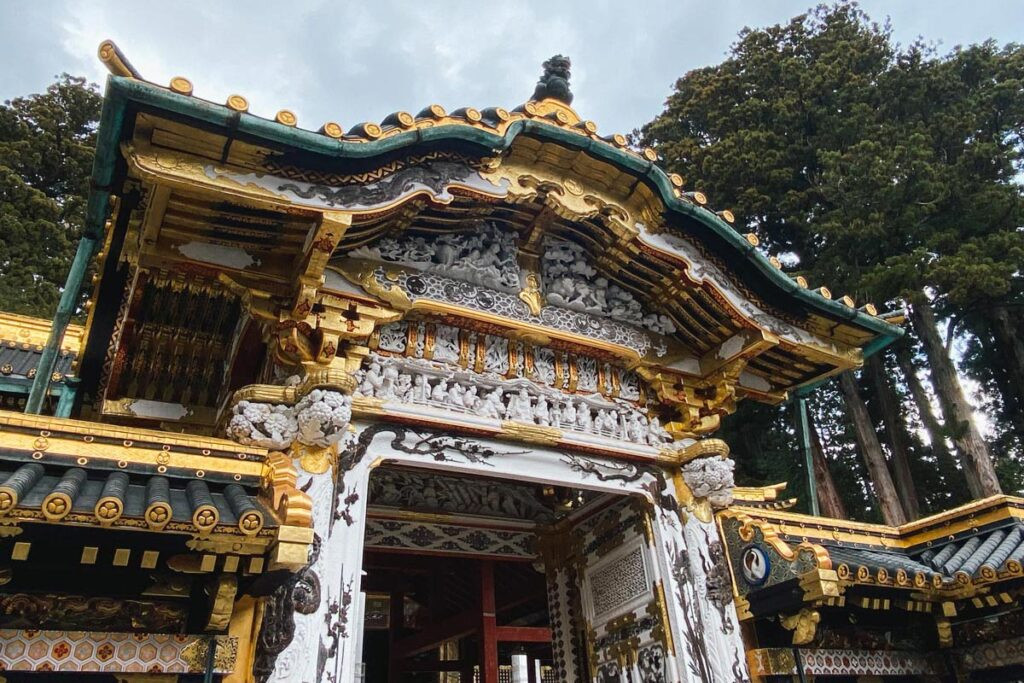 toshogu shrine Nikko
toshogu shrine Nikko
Given the longer travel time to Nikko, consider extending your stay to two days in Nikko instead of undertaking another day trip from Tokyo. If you opt for an overnight stay, explore the best ryokans in Nikko for an unforgettable traditional Japanese inn experience.
Day Trip Option 3: Kamakura & Enoshima – Seaside Towns & Coastal Charm
Kamakura and Enoshima are charming seaside towns situated close to each other, approximately one hour south of Tokyo by train. They are popular day trip destinations, attracting visitors with their numerous temples, serene beaches, and seasonal hydrangea blooms (especially beautiful in June).
Similar to Hakone and Nikko, Kamakura and Enoshima offer a cost-saving Freepass. The Enoshima-Kamakura Freepass includes round-trip transportation from Shinjuku Station, unlimited train travel within the Kamakura-Enoshima area on Odakyu lines, and discounts at participating attractions.
If you choose Kamakura and Enoshima for your day trip, consider these highlights:
- Enoshima Island Exploration: Dedicate 2–3 hours in the morning to explore Enoshima, a small, picturesque island connected to the mainland by a bridge. Visit Enoshima-jinja Shrine, Samuel Cocking Garden (botanical gardens with a lighthouse offering panoramic views), and Nakamise Street, Enoshima’s main shopping street lined with souvenir shops and seafood restaurants.
- Great Buddha of Kamakura (Kamakura Daibutsu): Visit Kotoku-in Temple to see the iconic Great Buddha of Kamakura, a monumental bronze statue of Amida Buddha. This impressive statue dates back to the 13th century and stands over 13 meters tall. It’s one of Japan’s most famous Buddhist statues and a symbol of Kamakura.
- Komachi Street Stroll: Explore Komachi Street, a bustling shopping street located near Kamakura Station. Komachi Street is filled with a variety of restaurants, cafes, boutiques, souvenir shops, and local food vendors, perfect for lunch and souvenir shopping.
Our detailed Kamakura and Enoshima day trip itinerary provides a more comprehensive guide and suggested route for your exploration.
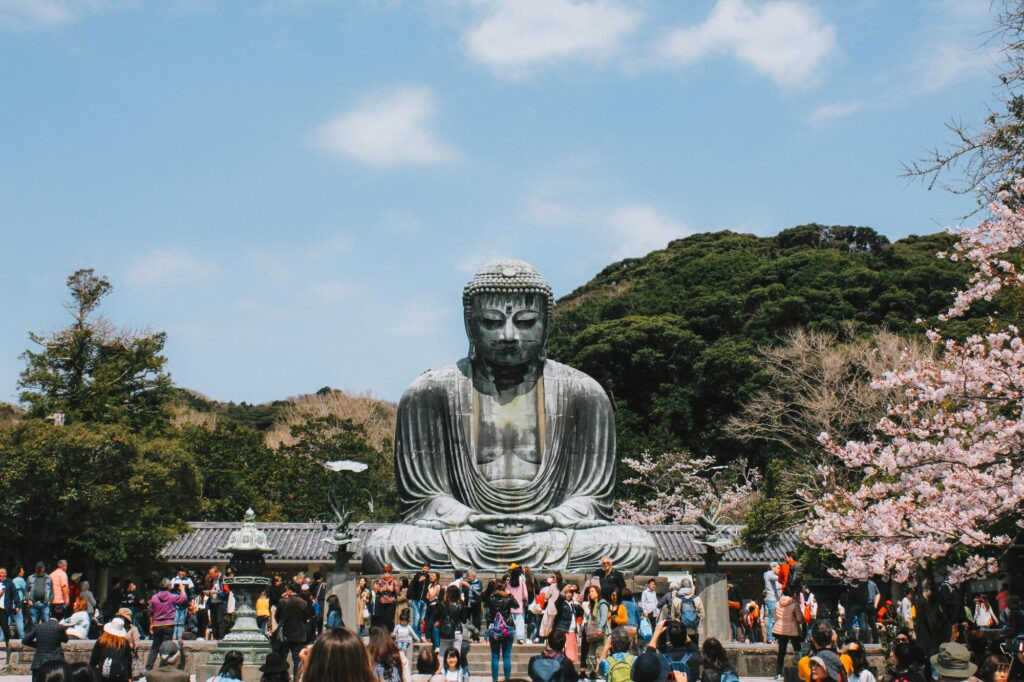 kamakura statue
kamakura statue
Days 7-9: Kyoto – Cultural Heart of Japan
After six enriching days in and around Tokyo, we journey westward to Kyoto, often considered Japan’s cultural capital. Kyoto is renowned for its concentration of traditional temples, serene gardens, exquisite shrines, and historic geisha districts. It embodies the essence of traditional Japan and is a highlight of any 2-week japan travel itinerary.
For your Kyoto accommodation, you have two options to consider:
- Option 1: Five Nights in Kyoto: Establish Kyoto as your base for five nights, allowing for day trips to nearby destinations like Osaka and Nara.
- Option 2: Three Nights Kyoto & Two Nights Osaka: Split your accommodation, spending three nights in Kyoto and two nights in Osaka. This allows you to experience the distinct atmospheres of both cities more fully.
The choice between these options won’t significantly impact the sights you’ll visit on this itinerary. However, Osaka offers a different urban vibe compared to Kyoto, often perceived as more modern and energetic, and accommodation in Osaka can sometimes be slightly more budget-friendly. Refer to my detailed Kyoto and Osaka comparison guide to help you decide which option best aligns with your preferences.
Regardless of your choice, you will spend at least a few nights in Kyoto. Our comprehensive guide on where to stay in Kyoto provides detailed neighborhood recommendations and hotel suggestions. Here are my top picks for first-time visitors:
| Area | Best For | Hotel/Ryokan | Book Now |
|---|---|---|---|
| Downtown Kyoto (Kawaramachi) | First-time visitors, central location, shopping & dining | Hotel Resol Kyoto Kawaramachi Sanjo | Check availability |
| Higashiyama District | Traditional atmosphere, temples, geisha districts | Kyoto Granbell Hotel | Check availability |
| Kyoto Station Area | Convenient for onward travel, transportation hub | Hotel Granvia Kyoto | Check availability |
Travel from Tokyo to Kyoto
The most efficient and fastest way to travel from Tokyo to Kyoto is by taking the Shinkansen, Japan’s bullet train. The Shinkansen journey between Tokyo and Kyoto takes approximately two hours and 15 minutes.
While the Japan Rail Pass (JR Pass) can be used for this Shinkansen journey, it’s important to note that due to significant price increases in October 2023, the JR Pass may no longer be the most cost-effective option for this specific 2-week japan travel itinerary.
Purchasing individual Shinkansen tickets is often more economical for this itinerary. You can purchase Shinkansen tickets at the train station on the day of your travel using ticket machines or by visiting the JR office for assistance from staff. Pre-booking Shinkansen tickets online in advance is also possible if you prefer to have your tickets secured before your trip.
Kyoto Highlights: Temples, Geishas, and Bamboo Forests
Day 7 of this itinerary involves traveling from Tokyo to Kyoto via Shinkansen. After arriving in Kyoto and checking into your hotel, consider taking it easy for the remainder of the day, especially after a busy first week of travel. Explore the immediate vicinity of your hotel, perhaps taking a leisurely stroll and enjoying a relaxing dinner. The interactive map includes some additional points of interest you can explore if you have extra time and energy.
This itinerary allocates two full days to explore Kyoto, which provides ample time to experience many of the city’s essential highlights. For a more detailed day-by-day plan, including a walking route through Kyoto’s geisha districts, refer to my comprehensive 2-day Kyoto itinerary guide. Here’s a summary of Kyoto’s must-see attractions:
- Fushimi Inari Taisha Shrine: Fushimi Inari Taisha Shrine is an iconic Shinto shrine famed for its thousands of vibrant red torii gates that wind up Mount Inari. This is personally my favorite spot in Kyoto, despite its popularity. The full hike to the summit and back down takes approximately 2–3 hours. Visiting early in the morning is highly recommended to avoid crowds and experience the shrine’s serene atmosphere.
- Geisha Districts (Gion & Higashiyama): Kyoto is synonymous with its historic geisha districts, primarily Gion and Higashiyama. These areas are characterized by traditional wooden machiya houses, teahouses, and cobblestone streets, evoking a sense of old Kyoto. Explore iconic temples within these districts, such as Kiyomizu-dera Temple (known for its wooden stage offering panoramic views), Kodai-ji Temple, and Yasaka Shrine. While these districts are popular with tourists, they remain essential for experiencing Kyoto’s traditional atmosphere. My 2-day Kyoto itinerary includes a free walking route to guide you through these districts.
- Kinkaku-ji Temple (Golden Pavilion): Visit Kinkaku-ji Temple, also known as the Golden Pavilion, a stunning Zen Buddhist temple covered in gold leaf and reflected in a tranquil pond. Kinkaku-ji is located slightly outside Kyoto’s central areas, requiring either a dedicated morning or afternoon visit. It’s one of Kyoto’s 17 UNESCO World Heritage Sites and a visually striking landmark.
- Arashiyama Bamboo Grove: Explore the Arashiyama Bamboo Grove, located in western Kyoto. This ethereal bamboo forest is one of the most photographed locations in Kyoto. The bamboo grove is open 24/7 and free to enter. Allocate a morning or afternoon to explore the Arashiyama area, which also includes Tenryu-ji Temple (a beautiful Zen temple) and Togetsukyo Bridge.
- Kimono Experience: Kyoto, with its traditional ambiance, is an ideal place to experience wearing a kimono, a traditional Japanese garment. Many kimono rental shops in Kyoto offer kimono rentals for a few hours or a full day. Professional dressers will assist you in wearing the kimono correctly. Renting a kimono and strolling through Kyoto’s traditional districts enhances your cultural immersion. Rest assured, respectfully wearing a kimono is not cultural appropriation.
- Pontocho Alley Dining: For an atmospheric dining experience in Kyoto, head to Pontocho Alley during one of your evenings (ideally after exploring the geisha districts, as it’s nearby). Pontocho is a narrow, lantern-lit alleyway running alongside the Kamogawa River, lined with restaurants and bars, many offering outdoor seating overlooking the river. Even if you don’t dine at a Pontocho restaurant, walking through this charming alleyway is a delightful experience.
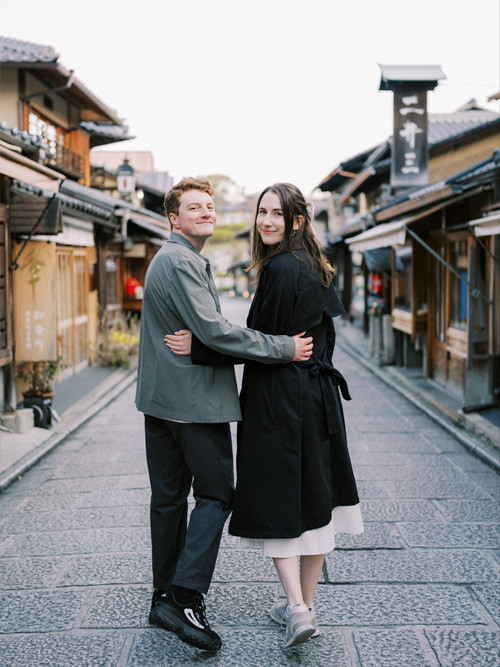 Nele and Richard in Kyoto
Nele and Richard in Kyoto
Day 10: Osaka – Japan’s Culinary Capital
Day 10 of your 2-week japan travel itinerary is dedicated to a day trip to Osaka, often called “the Nation’s Kitchen.” Osaka is renowned for its vibrant street food scene, lively atmosphere, and friendly locals. While some visitors might skip Osaka, it’s personally one of my favorite cities in Japan, offering a distinct urban experience compared to Kyoto.
Osaka is easily accessible from Kyoto, with a short 15-minute Shinkansen ride or a 30–40 minute train journey. Upon arrival in Osaka, explore these must-see attractions:
- Osaka Castle: Visit Osaka Castle, one of Japan’s most iconic castles and a symbol of Osaka. Osaka Castle played a significant role in Japan’s unification in the 16th century. Explore the castle museum to learn about its history and stroll through the surrounding Osaka Castle Park.
- Shinsekai District: Explore Shinsekai, a retro-futuristic district in Osaka developed during Japan’s industrial boom. Shinsekai’s iconic Tsutenkaku Tower is inspired by the Eiffel Tower and offers panoramic city views. Shinsekai is also a fantastic place to sample Osaka’s famous kushikatsu (deep-fried skewers) and other local street food.
- Namba Yasaka Shrine: Visit Namba Yasaka Shrine, known for its striking lion-head-shaped stage (Ema-den). Legend says the lion’s mouth swallows evil spirits and brings good luck. The shrine is free to visit.
- Nipponbashi Den-Den Town: If you’re interested in retro video games and electronics, explore Nipponbashi Den-Den Town, Osaka’s equivalent to Tokyo’s Akihabara. Find retro game shops, anime and manga stores, and electronics retailers.
- Dotonbori District: Experience the vibrant energy of Dotonbori, located in Osaka’s Minami (Namba) district. Dotonbori is the heart of Osaka’s nightlife and entertainment scene, famous for its dazzling neon lights, iconic Glico Running Man sign, street food stalls, restaurants, and theaters. It’s a must-visit in Osaka, especially in the evening.
My detailed one-day Osaka itinerary guide provides a more comprehensive plan and walking route for your Osaka exploration.
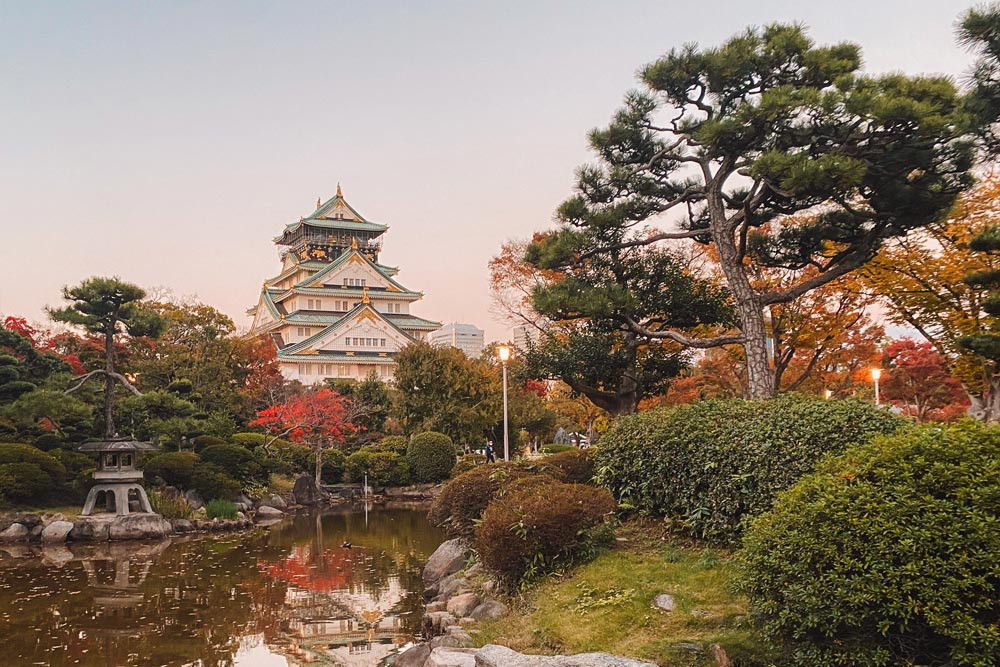 osaka castle at dusk
osaka castle at dusk
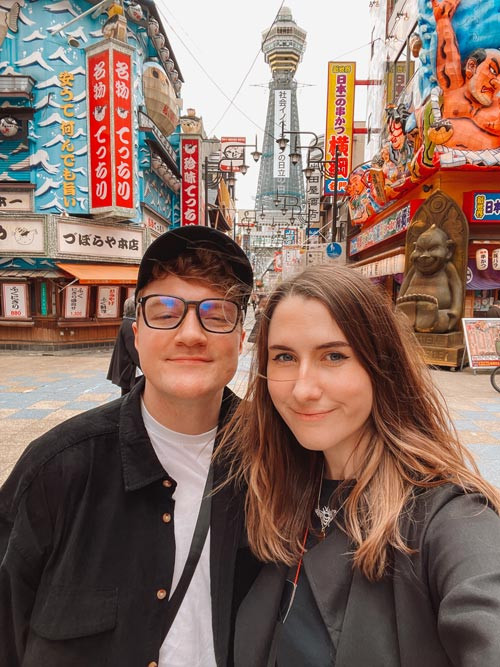 shinsekai osaka
shinsekai osaka
Osaka’s distinct atmosphere and culinary scene might entice you to extend your stay beyond a day trip. If you’re a nightlife enthusiast or a dedicated foodie, Osaka offers more options than Kyoto.
My in-depth guide on where to stay in Osaka recommends various areas and hotels in Osaka. Here’s a quick overview of my top three area recommendations:
| Area | Best For | Hotel | Book Now |
|---|---|---|---|
| Umeda/Kita District | First-time visitors, transportation hub, shopping | Sonezaki Luxe Hotel | Check Availability |
| Namba District | Nightlife, food lovers, central location | Karaksa Hotel Osaka Namba | Check Availability |
| Shinsaibashi District | Quieter area, close to Dotonbori, shopping | The Bridge Hotel Shinsaibashi | Check Availability |
Refer to my comprehensive Kyoto vs Osaka comparison guide to help you decide whether to base yourself in Kyoto or Osaka for a longer duration.
If you plan to visit Universal Studios Japan (located in Osaka), you can substitute one of the days allocated to Kyoto, Osaka, or Nara, as these cities are all conveniently located near each other.
Day 11: Nara – Deer Park & Ancient Temples
Day 11 features a day trip to Nara, which served as Japan’s capital in the 8th century. Nara’s historical significance is evident in its numerous ancient temples and shrines, making it a worthwhile addition to your 2-week japan travel itinerary.
Nara is easily accessible from both Kyoto and Osaka. From Kyoto, you can reach Nara via the JR Nara Line or the Kintetsu Nara Line. If using the JR Nara Line from Kyoto, opt for the Miyakoji Rapid service, which takes approximately 45 minutes (compared to 70 minutes on the JR Nara Local Train) for the same fare. On the Kintetsu Nara Line from Kyoto, choose the Express service (45 minutes) or the Limited Express service (35 minutes).
From Osaka, you can use the JR Yamatoji Line or the Kintetsu Nara Line to travel to Nara. The JR Yamatoji Line from Osaka Station to Nara takes approximately 45 minutes and also stops at Osaka Tennoji Station (30 minutes to Nara from Tennoji). The Kintetsu Nara Line from Osaka offers the Express option (35-40 minutes) or the Limited Express option (30 minutes).
Key sights and activities for your Nara day trip include:
- Nara Deer Park: Nara is world-famous for Nara Deer Park, home to over 1,200 wild Sika deer that roam freely throughout the park and even into the city streets. These friendly deer are accustomed to humans and will often bow to visitors in anticipation of deer crackers (shika senbei) sold throughout the park. Purchasing deer crackers and interacting with the deer is a quintessential Nara experience.
- Yoshikien Garden & Isuien Garden: Beyond Nara Deer Park, Nara boasts beautiful Japanese gardens. Isuien Garden, located near Kofuku-ji Temple, is a meticulously landscaped Japanese garden representing different garden styles, including a traditional zen garden. There’s an entrance fee for Isuien Garden, but it’s well worth it. Yoshikien Garden, adjacent to Isuien Garden, is smaller but offers free admission for foreign visitors and is also a lovely garden to explore.
- Todai-ji Temple: Visit Todai-ji Temple, a UNESCO World Heritage site and home to the Daibutsu, a colossal bronze Buddha statue. Todai-ji’s main hall, the Daibutsuden, is one of the world’s largest wooden structures, dating back to 752 AD. The sheer scale of the Daibutsuden and the imposing Daibutsu statue are awe-inspiring.
- Kasuga Taisha Shrine: Explore Kasuga Taisha Shrine, another UNESCO World Heritage site in Nara. Kasuga Taisha is renowned for its thousands of lanterns – approximately 2,000 stone lanterns lining the paths leading to the shrine and over 1,000 hanging bronze lanterns within the shrine buildings. While a significant portion of Kasuga Taisha can be visited for free, a small entrance fee is required to access the inner shrine area, where you can view the lanterns up close. Kasuga Taisha is personally one of my favorite spots in Nara.
My one-day Nara itinerary guide provides a detailed walking route and further information on transportation from Osaka and Kyoto to Nara.
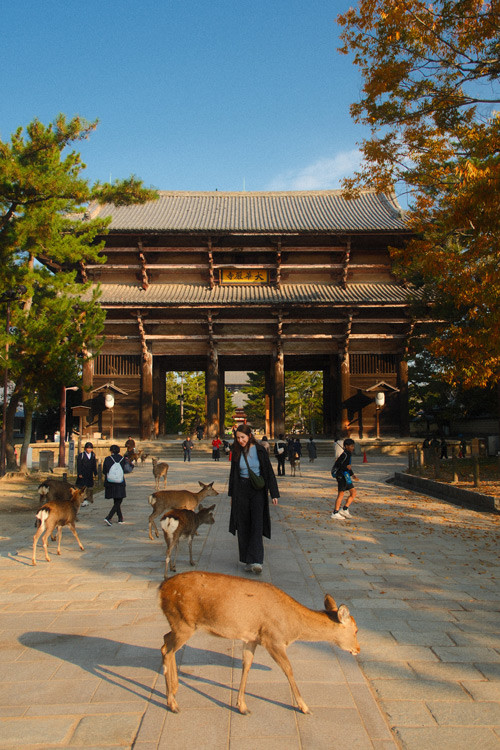 Nandaimon gate nara
Nandaimon gate nara
 todaiji temple in nara
todaiji temple in nara
Day 12: Himeji – Home to the Majestic White Heron Castle
As we approach the final leg of our 2-week japan travel itinerary, it’s time to pack your luggage again and begin moving towards your final destination, Hiroshima. I recommend booking your hotel in Hiroshima for the remaining nights of your Japan trip (or considering a final night in Osaka or Tokyo, depending on your departure airport and flight schedule).
En route to Hiroshima, plan a stopover in Himeji, a city famed for its stunning Himeji Castle, often nicknamed “White Heron Castle” due to its elegant white facade. Himeji is conveniently located on the Shinkansen line between Osaka/Kyoto and Hiroshima, making it an ideal day trip stop.
Upon arrival at Himeji Station, utilize the coin lockers available at the station to store your luggage, allowing you to explore Himeji hands-free.
Himeji Castle & Surrounding Attractions
For your day in Himeji, focus on exploring these key attractions:
- Himeji Castle: Himeji Castle, a UNESCO World Heritage site and a National Treasure of Japan, is the undisputed highlight of Himeji. Dating back to 1333, Himeji Castle is one of Japan’s finest and most well-preserved feudal castles. It’s one of the few Japanese castles that were never destroyed by fire or earthquakes. Allow ample time to explore the castle complex, climb to the main keep, and admire its intricate architecture and panoramic views.
- Himeyama Park: Adjacent to Himeji Castle, explore Himeyama Park, a pleasant parkland area surrounding the castle. The park features smaller shrines, a serene pond, and a moat inhabited by koi carp.
- Koko-en Garden: Visit Koko-en Garden, a complex of nine distinct Japanese-style gardens located near Himeji Castle. Each garden within Koko-en showcases different garden design principles and seasonal beauty. Koko-en also features a traditional tea house. Consider purchasing a combined ticket for Himeji Castle and Koko-en Garden for a cost-saving option.
My guide on how to spend one day in Himeji provides more detailed information on Himeji’s attractions, transportation, and a suggested itinerary route.
After exploring Himeji, retrieve your luggage from the station lockers and continue your Shinkansen journey to Hiroshima, where you’ll be based for the next few nights.
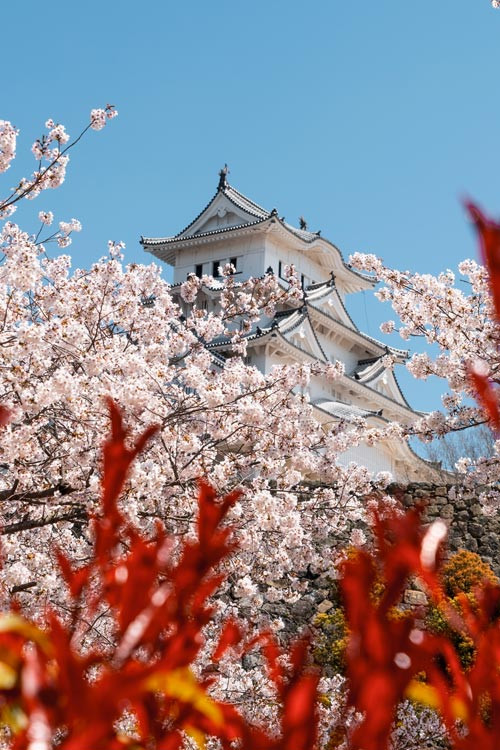 himeji castle sakura
himeji castle sakura
Day 13: Hiroshima – Reflection and Rebirth
Hiroshima serves as your base for the final days of your 2-week japan travel itinerary. Day 13 is dedicated to exploring Hiroshima City itself. Hiroshima is internationally recognized as the site of the atomic bombing on August 6, 1945. While deeply marked by this tragic history, Hiroshima has resolutely rebuilt itself into a vibrant and welcoming city, attracting hundreds of thousands of visitors annually.
When spending a day in Hiroshima, these are the essential places to visit:
- Hiroshima Castle (Carp Castle): Visit Hiroshima Castle, also known as Carp Castle, a reconstructed castle that offers insights into Hiroshima’s pre-war history. Explore the castle grounds and the main keep.
- Hiroshima Gokoku Shrine: Located near Hiroshima Castle, Hiroshima Gokoku Shrine is a Shinto shrine dedicated to those who died in service to Japan, including war casualties. The shrine’s imposing stone torii gate is a notable feature.
- Atomic Bomb Dome: Visit the Atomic Bomb Dome (Genbaku Dome), the skeletal remains of the former Hiroshima Prefectural Industrial Promotion Hall. Miraculously, the Atomic Bomb Dome was one of the few structures that partially survived the atomic bombing and has been preserved as a stark reminder of the devastation and a symbol of peace. It’s a UNESCO World Heritage site.
- Hypocenter of the Atomic Bombing: Locate the Hiroshima Atomic Bomb Hypocenter Monument, marking the precise point directly beneath where the atomic bomb detonated in the air. It’s located relatively close to the Atomic Bomb Dome, although somewhat hidden amongst modern buildings.
- Hiroshima Peace Memorial Park: Walk through Hiroshima Peace Memorial Park, a sprawling park dedicated to commemorating the victims of the atomic bombing and promoting world peace. The park contains numerous monuments, memorials, and sculptures, including the iconic Children’s Peace Monument (dedicated to Sadako Sasaki and child victims) and the Peace Memorial Museum.
- Hiroshima Peace Memorial Museum: Visit the Hiroshima Peace Memorial Museum, located within Peace Memorial Park. The museum offers a deeply moving and educational experience, documenting the history of Hiroshima before and after the bombing, the devastating impact of the atomic bomb, and the ongoing pursuit of peace. While emotionally challenging, visiting the Peace Memorial Museum is an essential part of understanding Hiroshima’s history and message.
- Hiroshima-style Okonomiyaki: Don’t leave Hiroshima without trying Hiroshima-style okonomiyaki, a local specialty. Okonomiyaki is a savory pancake-like dish made with cabbage, batter, egg, and various fillings (meat, seafood, noodles). Hiroshima-style okonomiyaki is distinct from Osaka-style okonomiyaki in its preparation method and layering of ingredients. Hiroshima Okonomi Monogatari is a popular food building with multiple okonomiyaki restaurants to choose from.
My guide on how to spend a day in Hiroshima provides more information for planning your Hiroshima exploration.
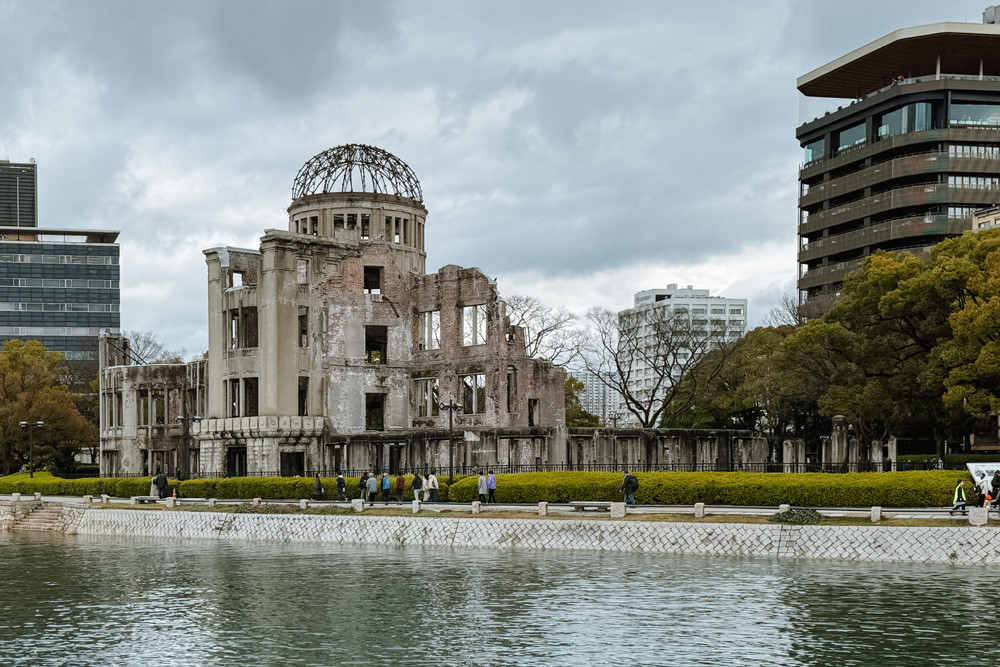 hiroshima dome
hiroshima dome
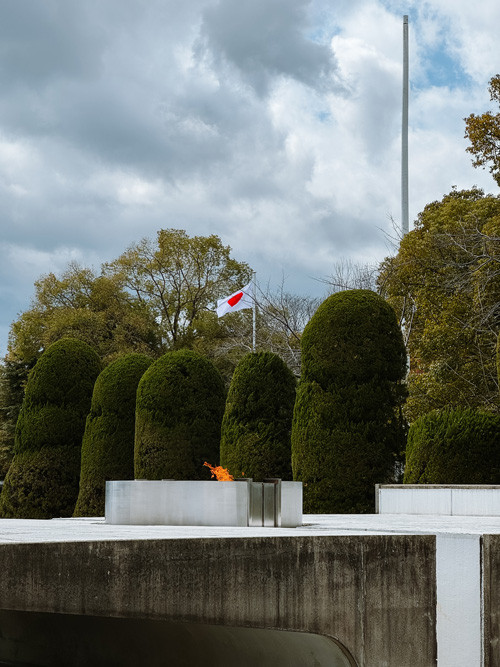 hiroshima peace flame
hiroshima peace flame
Day 14: Miyajima – Island Shrine and Floating Torii Gate
Day 14, the final day of your 2-week japan travel itinerary, is dedicated to a day trip to Miyajima Island from Hiroshima. Miyajima is a small island in Hiroshima Bay, famous for its iconic “floating” torii gate of Itsukushima Shrine, a UNESCO World Heritage site.
From Hiroshima Station, take the JR Sanyo Line to Miyajimaguchi Station (approximately 30 minutes). From Miyajimaguchi Station, a short ferry ride (about 10 minutes) will take you to Miyajima Island.
Key sights and activities on Miyajima Island include:
- Itsukushima Shrine & Floating Torii Gate: Explore Itsukushima Shrine, a Shinto shrine complex built over water. The highlight is the iconic red torii gate that appears to float on the sea at high tide. Visit the shrine’s Treasure Hall and admire the Grand Torii Gate from the main hall. At low tide, you can walk out to the base of the torii gate.
- Senjokaku Pavilion & Five-Story Pagoda: Climb the staircase leading up to Senjokaku Pavilion (Toyokuni Shrine), a large wooden pavilion originally intended as a temple but never fully completed. From Senjokaku, you’ll have a good view of the Seto Inland Sea and the nearby Five-Story Pagoda of Miyajima.
- Tenshinkaku Cafe: Enjoy coffee and cake at Tenshinkaku Cafe on Miyajima, which offers scenic views of the Five-Story Pagoda and the surrounding area. There’s a small entrance fee for the cafe area, but the views and refreshments are worthwhile.
- Mount Misen Hike or Ropeway: Ascend Mount Misen, Miyajima’s highest peak. You can hike to the summit (various trails available, ranging in difficulty) or take the Miyajima Ropeway up to Shishiiwa Station and then walk to the Mt. Misen Observatory. The summit of Mount Misen offers panoramic views of Miyajima Island and the Seto Inland Sea.
- Momiji Manju Tasting: Try momiji manju, Miyajima’s local specialty sweet treat. Momiji manju are maple leaf-shaped cakes typically filled with red bean paste (anko). They are widely available on Miyajima.
- Fresh Oysters: Miyajima is known for its fresh oysters, cultivated in the waters surrounding the island. Sample grilled oysters, a local delicacy, often seasoned with soy sauce.
Consult my comprehensive guide on how to spend one day in Miyajima for more detailed information and planning tips.
 miyajima gaint torii
miyajima gaint torii
Fresh grilled oysters, a local delicacy to savor on Miyajima Island.
After your Miyajima day trip, you can travel directly to the airport for your return flight home. If possible, consider flying out of Osaka’s Kansai International Airport (KIX) instead of returning to Tokyo. Traveling from Hiroshima to Osaka by Shinkansen takes approximately 1.5 hours, significantly shorter than the nearly 5-hour Shinkansen journey back to Tokyo, potentially saving you travel time and costs.
Is 2 Weeks Enough Time to See Japan?
Yes, two weeks is sufficient time to experience many of Japan’s major highlights, especially for a first-time visit. This 2-week japan travel itinerary covers Tokyo, Hakone, Kyoto, Osaka, Nara, Himeji, Hiroshima, and Miyajima, providing a comprehensive introduction to Japan’s diverse attractions.
If you have more time to explore Japan, consider my 3-week Japan itinerary, which includes additional destinations and deeper explorations. However, if you only have two weeks, this itinerary offers a well-paced and fulfilling first taste of Japan. Don’t be surprised if you find yourself already planning your return trip to Japan shortly after you get home!
Do You Need a JR Pass for a 2-Week Japan Itinerary?
For this specific 2-week japan travel itinerary, a Japan Rail Pass (JR Pass) is not necessary and may not be cost-effective. It is generally cheaper to purchase individual Shinkansen tickets for longer journeys and utilize a Suica or Pasmo card for local transportation within cities.
While the JR Pass was often recommended for similar itineraries in the past, significant price increases in October 2023 have altered the cost-benefit analysis. For this itinerary’s travel patterns, individual Shinkansen tickets and local transport cards will likely be more economical.
You can purchase individual Shinkansen tickets at train stations on the day of travel or pre-book them online if preferred. If traveling with luggage, inform station staff when purchasing tickets to ensure you are seated in a car with luggage storage space. Pre-booking Shinkansen tickets can be done through platforms like Klook.
Budgeting for Your 2-Week Japan Trip: How Much Will it Cost?
The cost of a 2-week japan travel itinerary can vary significantly depending on your travel style and spending habits. As a general guideline, for a mid-range budget, aim to budget approximately £2,500 per person for a two-week trip to Japan, excluding international flights.
This estimated budget encompasses accommodation, food, transportation within Japan, entrance fees to attractions, activities, and some souvenirs. Factors that can influence your budget include your choice of accommodation (hostels, budget hotels, mid-range hotels, luxury hotels, ryokans), dining preferences (street food, casual restaurants, fine dining), transportation choices (Shinkansen, local trains, buses), and shopping habits.
For a more detailed breakdown of typical Japan travel costs, refer to my comprehensive guide on the cost of going to Japan.
Conclusion: Your Unforgettable 2-Week Japan Adventure Awaits
This concludes my recommended 2-week japan travel itinerary, designed to provide an enriching and memorable first experience of Japan. While Japan offers endless possibilities for exploration, this itinerary provides a balanced introduction to the country’s highlights, blending vibrant cities, cultural experiences, and natural beauty.
Be prepared to be captivated by Japan’s unique charm and culture. Many travelers, myself included, find themselves wanting to return to Japan again and again after their first visit. If you have more time for your Japan travels or seek further itinerary ideas, explore my 3-week Japan itinerary for additional destinations. Alternatively, from Hiroshima, consider extending your journey to Fukuoka and exploring the Kyushu region with a week-long Kyushu itinerary.
For now, happy travel planning, and I wish you an incredible and unforgettable adventure in Japan!

